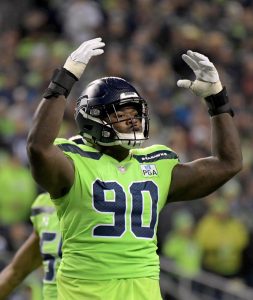The Seahawks recently restructured the contracts of two of their starting defensive linemen, Jarran Reed and Dre’Mont Jones. While the goal of most such transactions is to lower a player’s salary cap charge, that was not the case with Reed, whose cap number actually increased from $6.34MM to $6.47MM.
Reed, 31, had one year and $4.47MM left on his current deal, along with $900K in incentives. As ESPN’s Brady Henderson details in a thread on X, Seattle took $530K of those incentives and added them to the contract’s base value, while also adding $510K in per-game roster bonuses. The incentive package was originally based on sacks and playing time, and the $370K of incentives that remain are based exclusively on sacks (Reed will earn $185K if he records eight sacks, and he will unlock the full $370K if he hits the 10-sack threshold).
Per Henderson, the goal of this modification was to add a small contractual sweetener for a player who saw significant snaps for the ‘Hawks last season and who appears to be an integral part of new HC Mike Macdonald‘s plans. Indeed, the performance of Ravens interior defender Justin Madubuike had a positive trickle-down effect on the rest of Macdonald’s Baltimore defense, and while no one expects Reed to replicate Madubuike’s 2023 performance, the club does hope he will continue to generate a strong interior pass rush.
Meanwhile, the reworked Jones deal did create considerable cap room for the Seahawks, who were just $1.1MM under the cap after signing their rookie class. As Jason Fitzgerald of OverTheCap.com details, Seattle converted nearly $10MM of Jones’ 2024 base salary into a signing bonus and added two void years to the deal. Those void years carry $4.9MM in cap charges, and Jones’ 2025 cap number increased by roughly $2.5MM to a whopping $25.65MM, but his 2024 number decreased by $7.4MM, which should give the team plenty of breathing room to operate throughout the summer and into the regular season.
Jones signed a three-year, $51MM deal with the Seahawks last March, the largest contract that the team had ever authorized for an external free agent. He did not play poorly, but he did underperform relative to expectations, ranking as Pro Football Focus’ 55th-best interior defender out of 130 qualifiers (eight spots behind the more modestly-priced Reed). Despite his categorization as an interior lineman, Jones did begin to see more action on the edge last year in the wake of the season-ending pectoral strain that Uchenna Nwosu suffered in October.
As Bob Condotta of the Seattle Times details, Macdonald moved Jones around the formation during minicamp and had the former Bronco line up with the outside linebackers and edge rushers as well as with the defensive tackles. One of the reasons for the Ravens’ success under Macdonald was his ability to generate a strong pass rush from veterans like Jadeveon Clowney and Kyle Van Noy, and he will attempt to coax the same production out of Jones.
“I think his skillset lends to trying to play a little matchup ball with him or setting another guy up,” Macdonald said of Jones. “He can do a lot of things.”
One way or another, Macdonald plans to rotate his defenders quite a bit, so the team is not expected to subtract from its perceived glut of D-linemen, a group that also includes first-round draftee Byron Murphy II. Now that the ‘Hawks are comfortably under the salary cap, there is no financial reason for them to do so anyway.

Jones is a very specialized player, one who excels in one area much more than another. He’s a good pass rusher, but isn’t great at filling gaps or stopping the run. For that much money, Seattle was hoping that he would display some more versatility and every down production in their scheme, but he remained a pass rushing lineman without developing the solid run defense stops that would justify his regular use.
Thing is, Jarran Reed is sort of the same. He’s better than Jones in my opinion, and PFF seems to agree, but he’s more of a pass rusher than a run stopper. Unlike Jones, Reed has produced double digit sacks as a DI before. Quinton Jefferson was another DI who produced good pass rush but worse run defense last year. Jones is pretty streaky, even when compared to those two, and sometimes has bombshell games with a pair of sacks and sometimes spends four quarters overrunning running backs.
The Seahawks will probably have a potent pass rushing interior next year, or at least some good pressure from their linemen, however MacDonald ends up using them. After seeing what Maduibike did in that role, it’s encouraging for Seattle’s pass rush to put these elements together. The run defense, though, will likely need some work. My bet is that that’s what MacDonald is working the hardest at, or soon will be. They seem to have good tools for offering pressure, but will need to figure out a good plan for stopping the run to accompany that as the defense evolves.